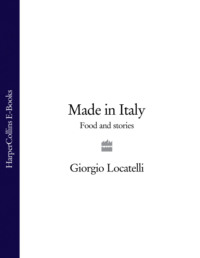
Полная версия
Made in Sicily
What is exceptional is that even in the small villages you still have two, three, four bakers, and they all make a living. Where we stay, outside Menfi, we are down by the beach, with a few little roads – not even roads, really, more like tracks, leading up to a ‘square’ – not even a square, really, just where the roads meet. And even here, there is a fantastic bakery, run by an English woman who is married to a Sicilian. The first time we went in and heard her speak English, we asked her where she was from, and she told us she grew up in Norwood, in south London. It seemed so strange to find her there in the middle of nowhere, where the wind blows tumbleweed down the streets some days, as if you are in a spaghetti western. Yet here she was baking beautiful bread over the embers of olive branches in a wood-burning oven. Imagine how much it would cost you in London to make your barbecue with olive wood – but here, where there are olive trees all around that must be trimmed, it is readily available. The olive branches give a special aroma to the bread, and when you take it home and unwrap it, it smells incredible. In parts of Italy, such as Lentini, where there are almond trees all around, they use the shells of the nuts in the wood-fired ovens, which gives a different character to the bread.
Theirs is a lovely, well-organised little bakery where they bake more than 400 kilos of bread every day; and what is amazing is that they bake twice a day, in the afternoon as well as at dawn. The bread they bake is typically Sicilian, made with farina di semola rimacinata (semolina flour), which is milled from hard durum wheat, the wheat that is used to make dried pasta. When you break the kernel of the wheat it shatters into semolina, which is then milled again into flour for bread. Like sourdough, the bread is made without commercial yeast, using a criscenti, or ‘starter’, ‘ferment’, or ‘mother’, whatever name people prefer to call it, according to their culture. In northern Italy we call it a biga. The name criscenti means ‘something that is allowed to grow’. For the first bread you bake, you cultivate your own natural yeast by mixing flour and water with something sweet and sugary, such as a pear, or grapes, then allowing it to ferment and grow over several weeks. Then, when you make your first batch of dough, you keep back a piece, and this is added to the next batch of dough, and so on, building up the strength and flavour of the dough. Some bakeries have criscenti going back over generations.
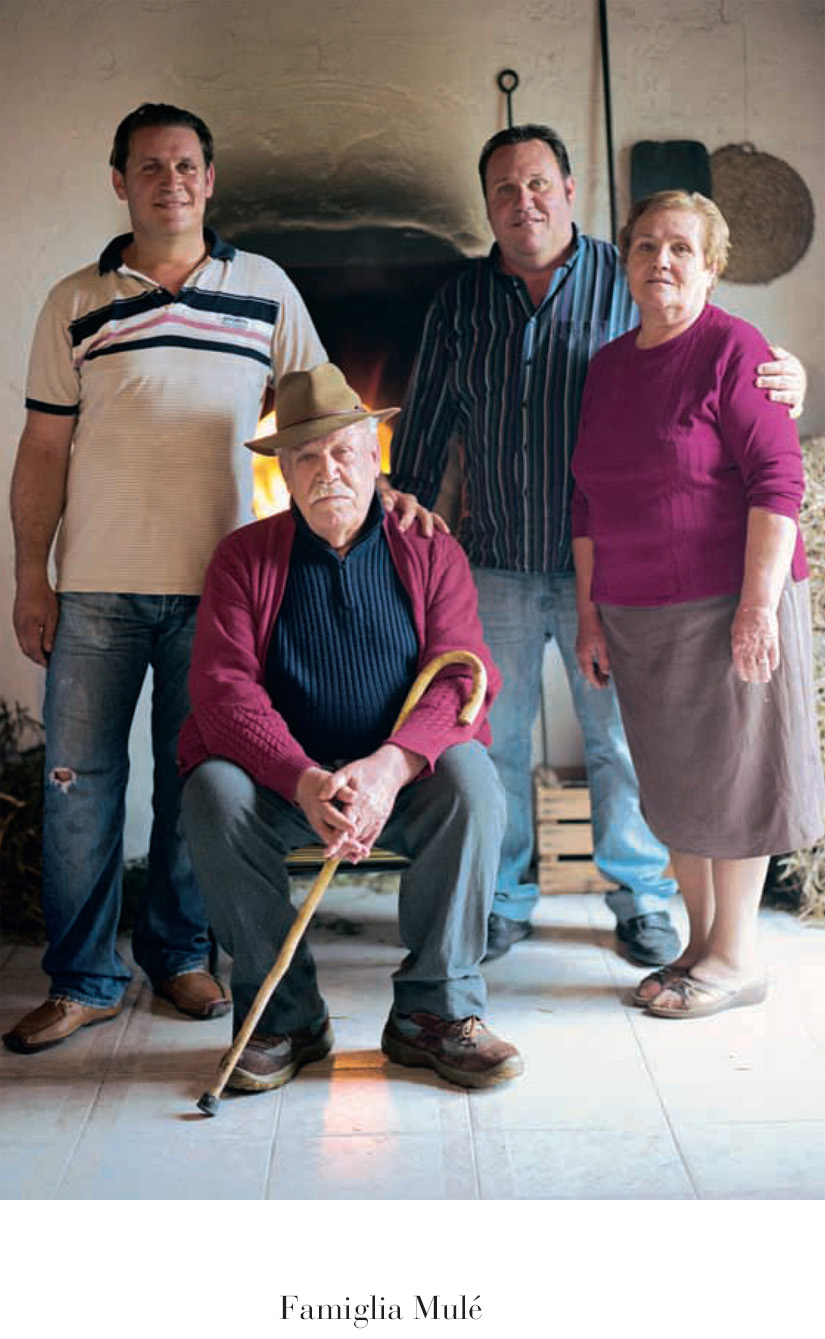
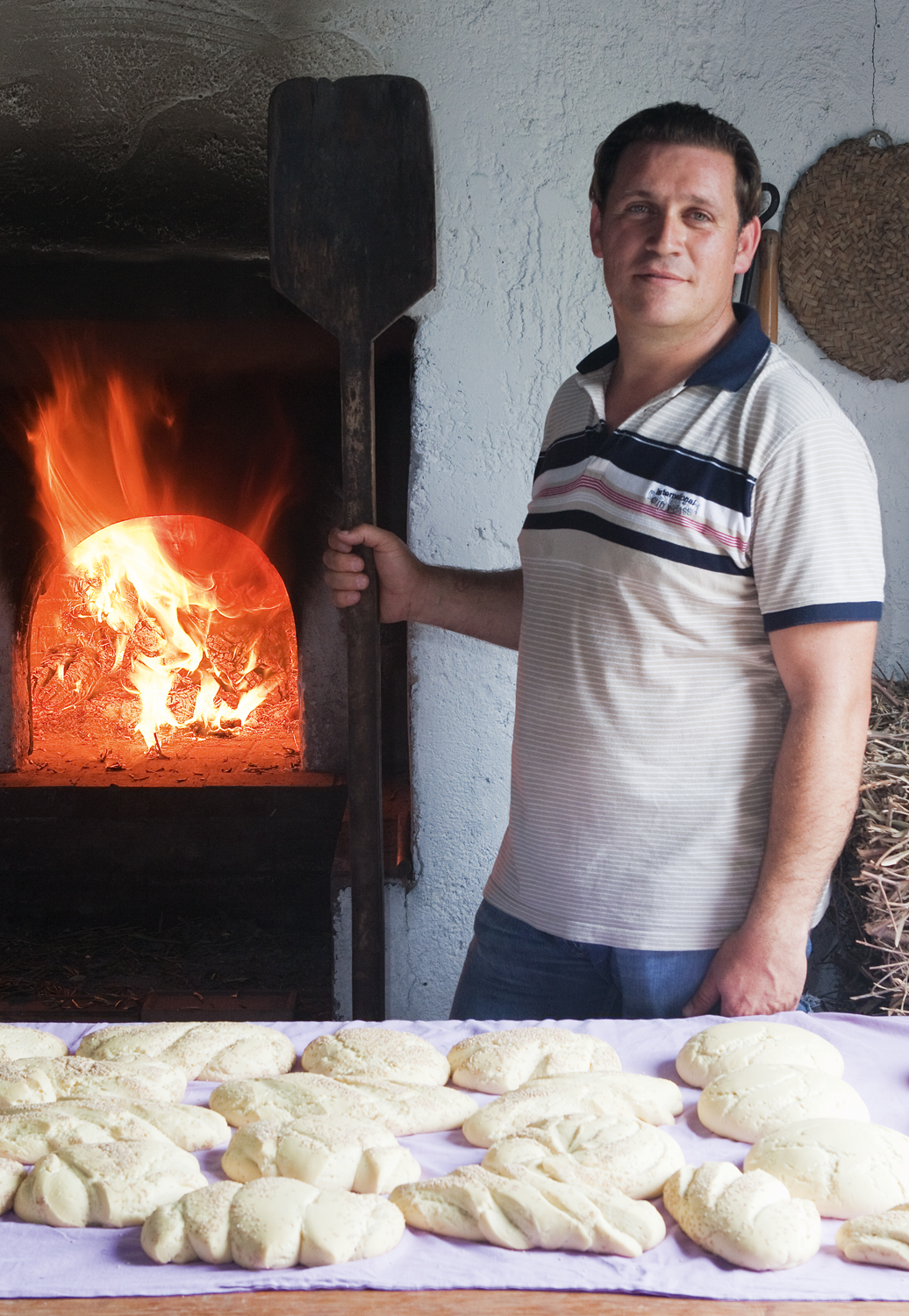
The baked bread is a beautiful golden-yellow colour, from the semolina, and quite heavy. In texture you can compare it to soda bread, but with a thick crust that typically has sesame seeds embedded in it. It is a bread that if you were to rub a sweet juicy tomato across, and sprinkle with olive oil, it would hold up and absorb the juices without becoming soft and disintegrating.
In the days of the barons, as happened in most cultures throughout Europe, white bread became fashionable and was considered more refined among the wealthy. What everyone else ate, although it was looked down on by the aristocracy at the time, was far tastier and more nutritious, and it is the bread that is treasured today in most communities, especially the small towns and villages, even if people buy it these days instead of making it at home. At one time everyone made their own bread, and if you didn’t have your own oven you could take your criscenti and flour down to the bakery, knead the dough in wooden tubs, called madie, then shape it into loaves and carve your initials into them, so that you would know they were yours. Then the baker would bake them for you to carry home, wrapped in cloths.
Between Agrigento and Trapani lies Castelvetrano which is also famous for the round pane nero di Castelvetrano, the local black bread, which is one of the many, very particular Sicilian foods, including other breads, that are being supported by the Slow Food movement. It is traditionally made by mixing stoneground semolina (which is less fine than semolina flour) with tumminìa, an ancient, local variety of wheat, which must also be stoneground. Again, the bread is quite dense and yellow, but when it comes out of the oven it has a magnificent, thick, chewy crust that is very, very dark, almost black.
One day we were invited to see the bread being made by the Mulé family who have a farmhouse and a piece of land in the valley behind Menfi, where the father and the sons grow beautiful courgettes, artichokes, potatoes and other vegetables, which they bring to the local restaurants. Like a lot of the elderly people in the area, the mother and father also have a little house down by the beach, in what used to be the swamp. In the garden they have a shed, with a big chimney sticking out of it, and inside is a wood-burning oven, where, every so often, they make a bit of a ceremony of baking the black bread.
As always, they use all the branches and clippings from the olive trees, which they have in square bales, stacked up outside. The oven is made with refrattario (refractory) bricks, the ones that are used for pizza ovens, so when the branches are lit, it will reach about 480–500°F. When the roof of the oven turns white, they sweep out all the ashes but they don’t throw them away, they put them down in a different part of the garden, ready to grill some bacon and cheese and salami, to have with the fresh bread. The oven is capable of baking around twelve kilos of dough – about twenty-four loaves – so whenever they bake bread, inevitably all the brothers and sisters, aunts and uncles, cousins and friends will turn up, to eat some, and take some away with them.
When the floor of the oven is swept out, the round loaves, scattered with sesame seeds, are put inside, and the smell from the olive branches is incredible. The door is closed, and after five or six minutes they check the bread, and from the way it looks, they are able to decide how long they are going to bake it for, which is about twenty to thirty minutes, as the oven slowly cools down.
As well as the semolina bread, in the local bakeries – around a dozen in my area alone – you can find pizza, topped with anchovies, olives and tomatoes (Pizza alla siciliana), and various stuffed breads made with a softer, focaccia-like dough, such as schiacciate (Schiacciata con salsiccia), which are like pies, made with a thick piece of dough underneath and a thinner one over the top, and inside all kinds of fillings, from cauliflower and sausage, to ricotta, sardines, anchovies, tomatoes, onion, eggs, ham and peas. You find them in the bars too, with a slice cut out of them so that you can see what the filling is, and you order a piece with your drink.
There is one baker who makes sfincione, which is more of a Palermo speciality. When I was there, outside one of the best bakeries, so many people were waiting for the sfincione that the baker spent all morning shouting, ‘Not till eleven o’clock!’ (when they would be ready). Even if the people just happened to be walking down the street, he would shout it anyway. Sfincione is like a pizza, but made with a quite deep, spongy dough and topped with ricotta and onions, sometimes sausage, sometimes anchovies or sardines. The famous one is the sfincione di San Vito, the one made by the nuns at the convent of St Vito in Palermo, which must have been such an incredible powerhouse of baking. It is topped with tomatoes, olives, potatoes, sausage and cheese.
The other thing that is done with bread dough is mpanata, another sort of pie, which takes its name from the Spanish empanada and is half-moon-shaped, like a Cornish pasty. The mpanate can be savoury or sweet – at Easter they are made with lamb – and on the west coast of Sicily they are often done with swordfish (Mpanata di pesce spada).
On special saints’ days and on the feast of San Giuseppe, which is Father’s Day, on 19 March, breads are made in elaborate shapes, and at Easter the shops are filled with special breads for children, shaped like little bags, or doves, which hold hard-boiled eggs: a reminder of times when people could not afford chocolate, and these, made at home for the children, would be a special treat.
Pangrattato Breadcrumbs
‘Every crumb is sacred’
Bread is sacred. If the people see you throw it away, they will really tell you off because the crumbs are so valuable in cooking – as a coating for fish, a thickener in things like polpettine (balls of meat or fish), or in stuffings. It is such a bad thing, that it used to be said that if you dropped even a crumb, you would spend hundreds of years in purgatory, picking up crumbs with your eyelashes. When times were harder and you had no cheese, you would sprinkle breadcrumbs over your pasta instead, with a little bit of garlic and parsley. I have even seen meat being grilled in the restaurants in Palermo, dusted with some very fine crumbs, garlic and parsley, just to give a little crunch to the outside.
In the old days families would have grated or crushed every piece of unused bread to make breadcrumbs in different sizes, because each size has its own purpose. Some would be left large, some sieved fine or medium, and then they would be kept in separate containers, in the way that my grandmother used to keep her breadcrumbs in big jars. Nowadays, most people don’t need to do this all the time, because when you buy your bread in the bakery, you can always pick up a kilogram bag of breadcrumbs at the same time. Whatever bread the bakery doesn’t sell in a day is put into the top of the ovens for two days to dry it out, then grated into breadcrumbs for people to buy. We make our own the same way at Locanda, with the michette, the puffed-up bread rolls ‘with five faces’, which are baked freshly every day in the kitchen, along with all our other breads. Those michette that are left over sit on top of the big bread oven overnight. Even when it is switched off, it retains enough heat to dry the bread and give us all the breadcrumbs we need.
At home making breadcrumbs is such an easy thing to do. If you have cooked something in the oven, when you switch it off, cut your stale bread into slices, put it on a baking tray and leave it in the oven overnight to dry out. Or you could just set your oven to 80°C and put the bread in for an hour. Of course, you need good bread, not the remains of a doughy, sliced loaf – those are only good for the ducks. When the bread has dried out, it is ready for grating. You could also put the bread into a blender and just press the pulse button very quickly, until you have the fineness you want, but I prefer to use a grater, which somehow seems to give an extra fluffiness to the crumbs.
What I also like about grating the crumbs is that they will all be different sizes, much less uniform than if you make them in a machine. These random-sized crumbs, which often have bits of crust mixed in with them, are what I call large crumbs, and are mostly used as a thickener, or in stuffings. If you put them through a fine sieve, they will become medium, and these are the ones that are used to coat fish or meat. If you want fine breadcrumbs, put them through a sieve yet again. Fine crumbs are used to give crunch to the arancini (Arancini al sapore di mare), or the timbales (Timballo di riso con pasta and Timballo di maccheroni.)
Medium breadcrumbs are also often toasted dry in the oven, or in a little olive oil in a pan, and these are the ones that are used to scatter over pasta. As I read in one Sicilian cookery book, they need to be toasted until they become ‘il colore di una tonaca di monaco’, the colour of a monk’s tunic, which helps you to understand how dark they should be – not just golden, but brown.
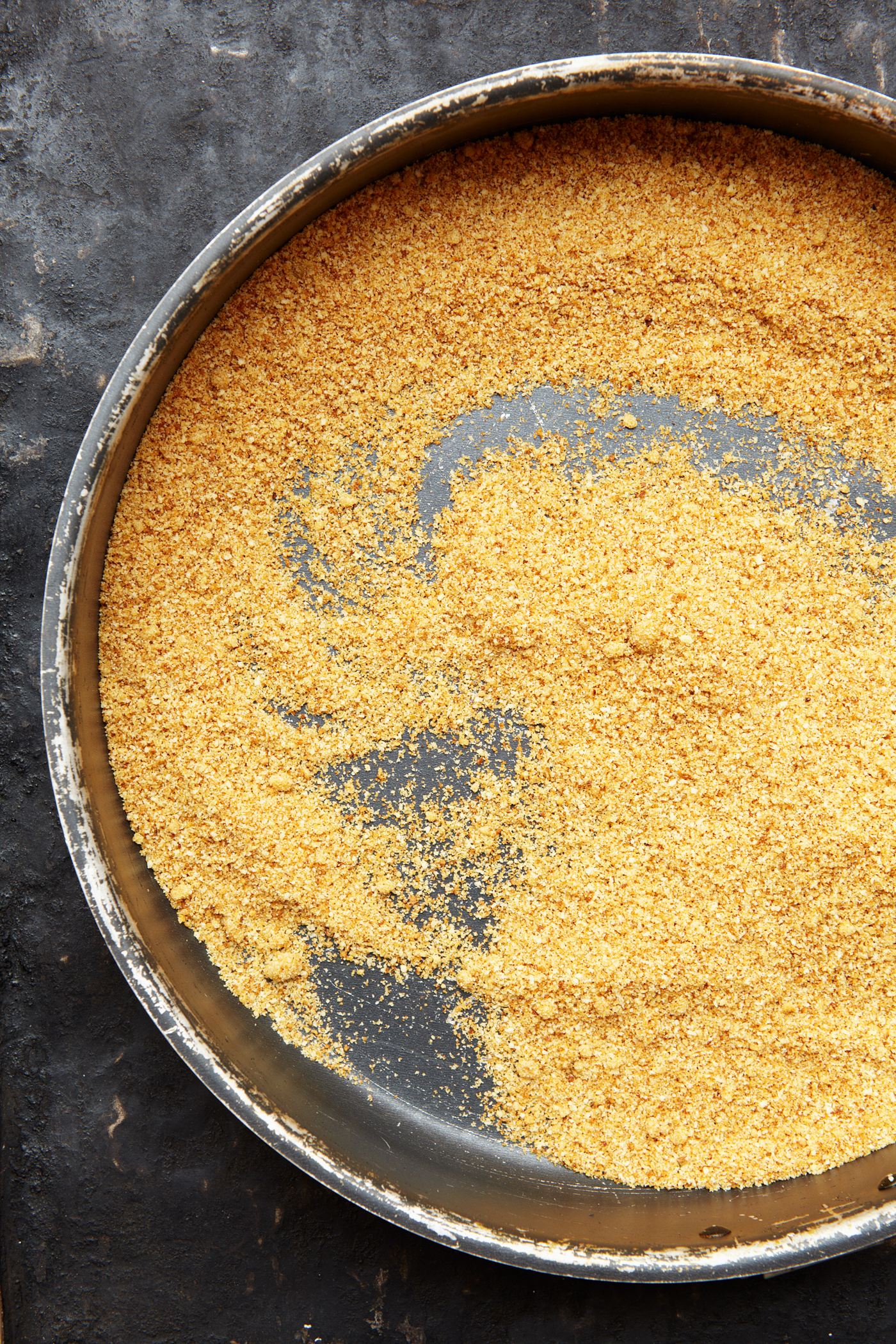
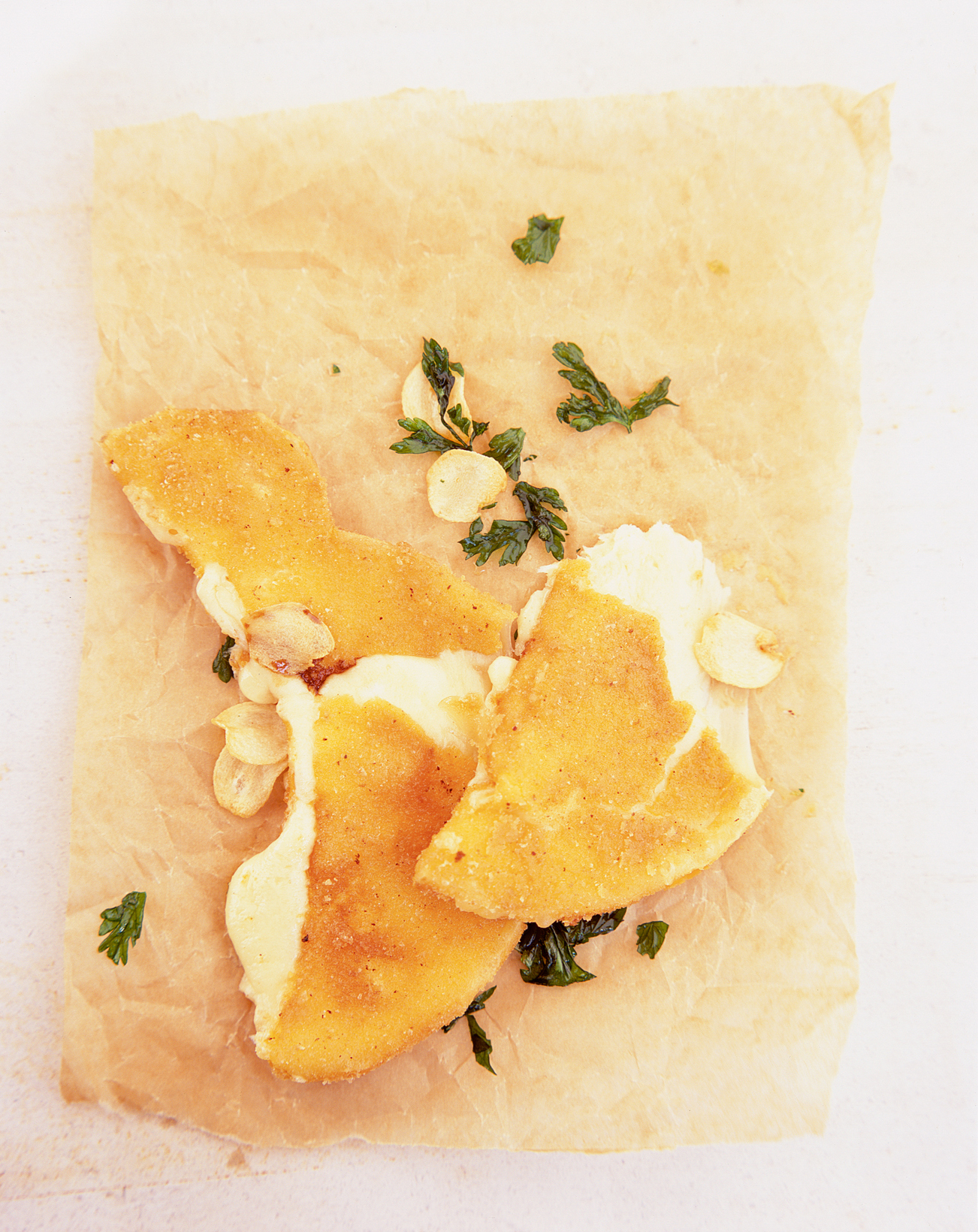
Cáciù all’argintéra
Fried cheese
This is very similar to a dish from Palermo known as formaggio all’argentiera, or the cheese of the silversmith. The story goes that the silversmith invented the dish because when it was cooking it smelt very like rabbit – although he was too poor to eat rabbit, he didn’t want his neighbours to know it.
When you read ‘fried cheese’, you might not think this sounds very enticing, but it is only when you make it that you understand how the typically Sicilian flavours work together to give you something really tasty.
Serves 4
25ml white wine vinegar
25ml white wine
50g sugar
200g breadcrumbs
½ tablespoon garlic oil
2 teaspoons chopped fresh oregano
450g caciocavallo or pecorino cheese (Caciocavallo cheese)
1 egg, beaten
vegetable oil for deep-frying
To make the sauce, put the vinegar and wine into a pan with the sugar and bring to the boil, stirring until the sugar dissolves. Take off the heat and keep to one side. Put the breadcrumbs, garlic oil and oregano into a blender and whiz until the herbs are finely chopped and the breadcrumbs are infused in the oil. Cut the cheese into pieces about 1cm thick. The thickness is important, otherwise the cheese won’t melt.
Have the beaten egg and herby breadcrumbs ready in two shallow bowls, then pass the strips of cheese through the egg and dip them into the breadcrumbs, turning to coat them. Repeat this three times for each strip, so that you end up with quite a thick coating of breadcrumbs.
Heat some oil in a pan (make sure the pan is big enough so that the oil comes no more than a third of the way up). It should be 180°C. If you don’t have a thermometer, test that it is hot enough by putting in a few breadcrumbs. If they sizzle straight away, the oil is ready. Deep-fry the cheese strips, in batches if necessary, for 2 minutes, until golden on all sides, and serve with the sauce.
Ramacché
Prosciutto and cheese fritters
When you go to the beach on Sundays you see families with boxes of these little fritters, which are eaten cold, along with things like peppers or cauliflowers, dipped in pastella (batter) and deep-fried.
Serves 4
30g unsalted butter
a small pinch of salt
150g plain flour, plus more as needed
3 large eggs
150g prosciutto crudo, diced
100g caciocavallo or pecorino cheese, grated
2 tablespoons parsley and garlic
sunflower oil for deep-frying
Put the butter and salt into a pan with 220ml of water and bring to the boil, then remove the pan from the heat and stir in the flour with a wooden spoon. Put the pan back on the heat and work the mixture continuously with the spoon until it comes together in a solid ball of dough. Take off the heat again and let it cool, then put the dough into a food mixer with a paddle, add the eggs one by one and mix until they are all incorporated.
Add the prosciutto, cheese and the parsley and garlic, and continue to mix. The dough will be quite soft.
Heat several centimetres of oil in a pan (make sure the oil comes no higher than a third of the way up). It should be 180°C. If you don’t have a thermometer, test that the oil is hot enough by dropping in a little bit of the dough. If it sizzles the oil is ready.
Moisten a dessertspoon with water, then scoop out little mounds of dough, slide them carefully into the oil and let them fry gently for about 2 minutes, turning them so they are golden on both sides, and reducing the heat if they start to brown too quickly. Remove the ramacché with a slotted spoon, drain on kitchen paper, and serve hot.
Pizza alla siciliana
Sicilian pizza
In every bakery all over Sicily, there is freshly made pizza, cut into pieces, ready for people to take home. I always buy some, along with the different breads, to have as an antipasto. And if you go into the local bar and have an aperitivo, they will give you a little pizza to eat with it.
The difference between these pizzas and the ones we are more familiar with elsewhere in Italy is that there is not much use of mozzarella. There are no buffalo on the island because they need to wallow in mud and water, so the mozzarella di bufala is always brought in from Campania, just outside Naples. There are also very few herds of cows, so the production even of cow’s milk mozzarella is fairly small. Instead, the concentration is on typical Sicilian ingredients, such as olives, anchovies and tomatoes, scattered with tuma, the local fresh, unsalted sheep’s milk cheese.
You need to choose good-quality black olives, with the stones still in, then pit them yourself – because the intense olive flavour is concentrated around the stone. You must remember that black olives aren’t actually black at all, but a deep purple-brown, depending on the variety. They are olives that have started out green but have been allowed to mature on the tree. As their colour darkens, their flavour becomes more intense and they become softer and more oily. Avoid the shiny jet black ones that you find on many commercial pizzas, or in jars in the supermarket, which are something different completely. These are actually green olives that have been put into a water bath with oxygen running through it, to turn them black, so that manufacturers can market them as a black olive that has the firmness of a young green olive. They just taste insipid, and nothing like a real ‘black’ olive.
The Sicilian black olives we use in the kitchen are mature nocellara and cerasuolo. These are the olives that are picked green and pressed to make our oil, but sometimes if a tree bears only a little fruit, the olives are left on the branches to ripen until they become ‘black’.
When you are making the pizza dough, the order in which you mix the ingredients makes a difference. It is best to dissolve the yeast in water and mix it into the flour before adding the salt, as the salt burns the yeast and makes it less effective. Once you have added the salt, the small quantity of sugar helps the fermentation. The oil is added last, as if you put it in at the beginning of mixing it acts like a skin, stopping the salt and yeast penetrating properly.
There are three stages that help get a great, crispy base to a pizza. First, rest the dough in the fridge but bring it to room temperature for three hours before shaping it. This is the system we have developed, because we are a restaurant not a bakery, so we have no proving room. If you can, rest it for twenty-four hours, as the longer it has to relax the more stretchy and pliable it will be, which makes it easier to get a good, thin base. Next, don’t overload the topping, as this will stop the base from crisping quickly; and finally, try to recreate the atmosphere of a dedicated pizza oven, in which the temperature is 260°C/500°F. The pizzas go straight on to the hot brick base and hot air cooks the topping at the same time. At home, have the oven at its highest temperature – usually 250°C/475°F/gas 9 – then put as many terracotta pizza bases, or upturned baking trays, as you can fit into the oven so that they get really hot, before carefully sliding a pizza on to each one. If you are making six pizzas, you will surely still have to bake them in batches, but as each one only takes ten minutes, no one will have to wait too long! Remember that leaving the door open lowers the temperature. In with the pizzas, as fast as you can, then shut the door.
Makes 6 pizzas (25–30cm)
7g fresh yeast
550g ‘00’ flour, plus extra for the bowl and rolling out
15g sea salt
6g sugar
60ml milk
30ml olive oil
For the topping:
24 good whole purple-black olives in brine
18 anchovies, either salted or in oil
2 tablespoons tomato sauce
1 medium onion, thinly sliced
100g tuma (Sicilian unsalted sheep’s milk cheese) or pecorino, grated
1 teaspoon dried oregano
freshly ground black pepper
1 tablespoon extra virgin olive oil
Dissolve the yeast in 300ml of water in a small bowl. Put the flour into a large bowl and mix in the yeast mixture. Add the salt and sugar, then the milk, little by little, followed by the oil, until all the ingredients are incorporated in a dough – this will take about 10 minutes. Scrape the dough into a floured bowl and fold it in on itself a few times. Cut it into 6 equal pieces and roll each one into a ball. Put the balls of dough on a tray, cover with clingfilm and leave to rest in the fridge for 24 hours.
Bring the dough out of the fridge and into room temperature 3 hours before you want to use it.
When ready to make the bases, preheat the oven to 250°C/475°F/gas 9, or as high as possible, and put in one or two terracotta bases or upturned baking trays (or however many you can fit in your oven).
Lightly flour a work surface, then, using your fingertips, press each ball of dough lightly into a thin round, about 25–30cm. You want the base to be about 3mm thick, but with a slightly thicker rim. If the dough feels too hard to shape easily, leave it to rest for 5 minutes and then come back to it.
Drain the olives and pat dry. With a sharp knife, make three or four cuts in each olive from end to end, and then cut each segment away from the stone as carefully as you can and roughly chop.
If using salted anchovies, rinse and dry them. Run your thumb gently along the backbone to release it, then you should be able to easily pull it out. If using anchovies in oil, drain them.
Chop the anchovies roughly and put some of the pieces on to each round of dough, pressing them in so they don’t get burned and bitter by being on top of the pizza. Spread some tomato sauce over each anchovy-studded base, then scatter with onion, cheese, olives and oregano, season with pepper and drizzle with a little extra virgin olive oil.
Slide the first pizza(s) on to the preheated base(s), and bake for about 10 minutes, or until the dough is golden and crunchy underneath. Repeat until all the pizzas are baked.
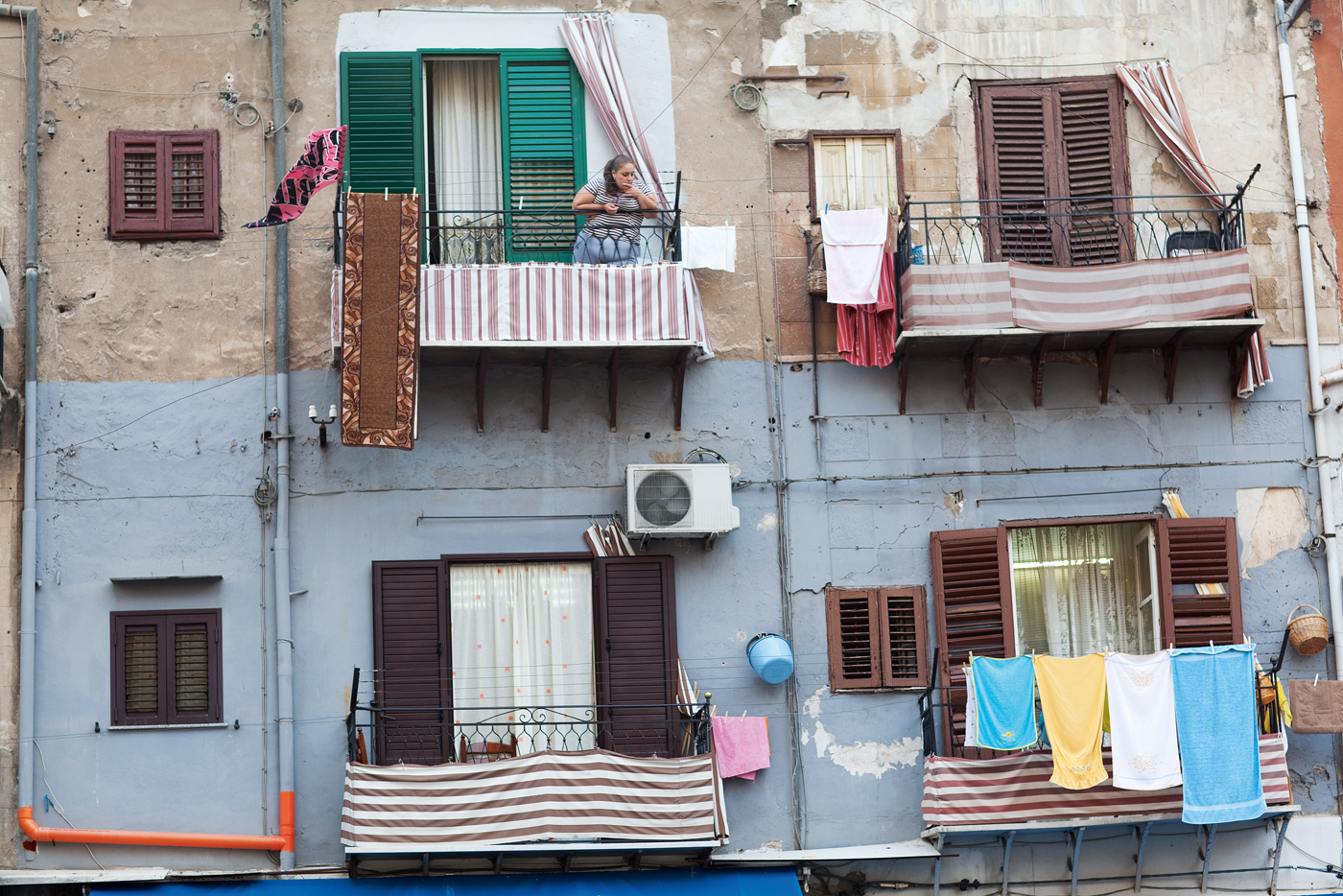
Pizza arrotolata
Rolled pizza with sausage
These rolled pizzas are made with the same dough as in the previous recipe, but rather than being floured, it is oiled at various stages, to keep it pliable enough to roll. Traditionally, the filling would be made with strutto, pure pork fat, but you can substitute olive oil.
Makes 4 rolls
7g fresh yeast
550g ‘00’ flour
15g salt
1 teaspoon sugar
60ml milk
30ml vegetable oil, plus more for oiling
For the filling:
4 tablespoons melted strutto or olive oil
450g fresh sausage meat, crumbled
6 tablespoons chopped pancetta
2 medium onions, chopped
120g pecorino cheese, grated
freshly ground black pepper
Dissolve the yeast in 300ml of water in a small bowl. Put the flour into a large bowl and mix in the yeast mixture. Add the salt and sugar, then the milk, little by little, followed by the oil, until all the ingredients are incorporated in a dough – this will take about 10 minutes. Scrape the dough into a bowl that has been lightly oiled with vegetable oil, and fold it in on itself a few times. Cut it into 4 equal pieces, shape each one into a rough square shape and rub with a little more oil. Put the squares of dough on a tray, cover with clingfilm and leave to rest in the fridge for 24 hours. Bring the dough out of the fridge and into room temperature 3 hours before you want to use it.
When ready to make the pizzas, preheat the oven to 220°C/425°F/gas 7 and put in one or two baking trays to get hot. Lightly oil a sheet of baking parchment and roll out the dough into squares measuring roughly 25–30cm, and 3mm thick. If it feels too hard, leave it to rest for 5 minutes.






